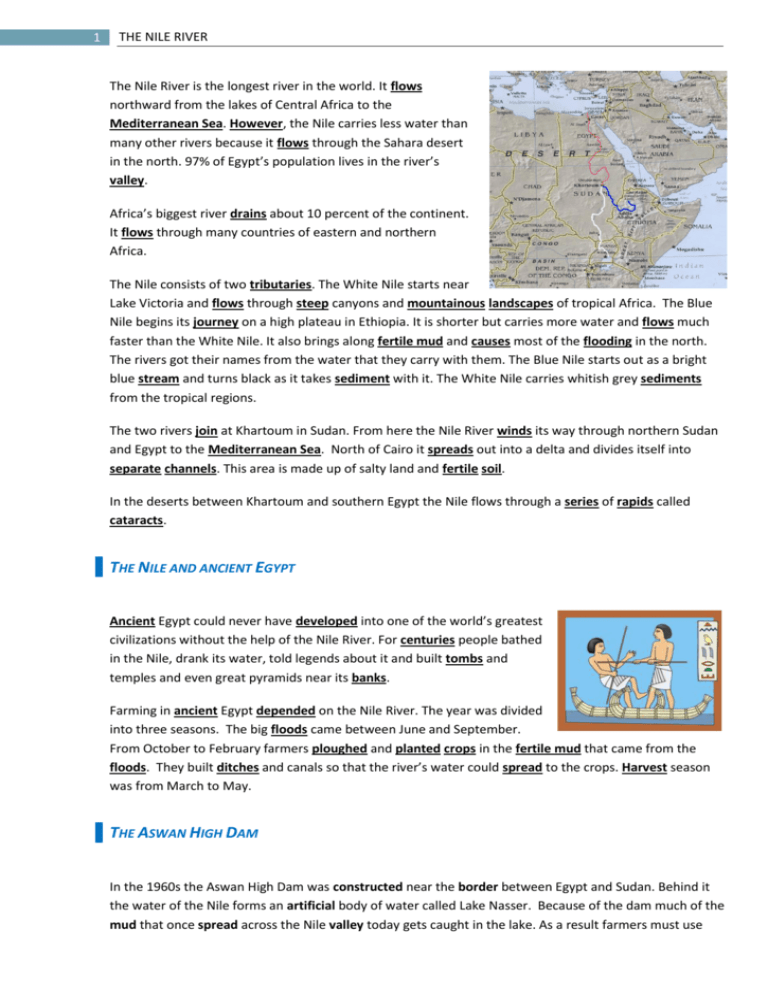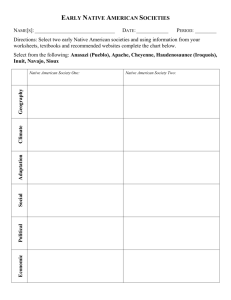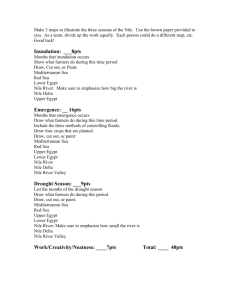the nile river - English Online
advertisement

1 THE NILE RIVER The Nile River is the longest river in the world. It flows northward from the lakes of Central Africa to the Mediterranean Sea. However, the Nile carries less water than many other rivers because it flows through the Sahara desert in the north. 97% of Egypt’s population lives in the river’s valley. Africa’s biggest river drains about 10 percent of the continent. It flows through many countries of eastern and northern Africa. The Nile consists of two tributaries. The White Nile starts near Lake Victoria and flows through steep canyons and mountainous landscapes of tropical Africa. The Blue Nile begins its journey on a high plateau in Ethiopia. It is shorter but carries more water and flows much faster than the White Nile. It also brings along fertile mud and causes most of the flooding in the north. The rivers got their names from the water that they carry with them. The Blue Nile starts out as a bright blue stream and turns black as it takes sediment with it. The White Nile carries whitish grey sediments from the tropical regions. The two rivers join at Khartoum in Sudan. From here the Nile River winds its way through northern Sudan and Egypt to the Mediterranean Sea. North of Cairo it spreads out into a delta and divides itself into separate channels. This area is made up of salty land and fertile soil. In the deserts between Khartoum and southern Egypt the Nile flows through a series of rapids called cataracts. THE NILE AND ANCIENT EGYPT Ancient Egypt could never have developed into one of the world’s greatest civilizations without the help of the Nile River. For centuries people bathed in the Nile, drank its water, told legends about it and built tombs and temples and even great pyramids near its banks. Farming in ancient Egypt depended on the Nile River. The year was divided into three seasons. The big floods came between June and September. From October to February farmers ploughed and planted crops in the fertile mud that came from the floods. They built ditches and canals so that the river’s water could spread to the crops. Harvest season was from March to May. THE ASWAN HIGH DAM In the 1960s the Aswan High Dam was constructed near the border between Egypt and Sudan. Behind it the water of the Nile forms an artificial body of water called Lake Nasser. Because of the dam much of the mud that once spread across the Nile valley today gets caught in the lake. As a result farmers must use 2 THE NILE RIVER fertilizers to grow crops, but the good side is that irrigation can be controlled and farming can be done the whole year round. The dam also produces electricity for most of Egypt. PLANTS AND ANIMALS The Nile flows through many climatic regions. Grasslands accompany the banks of the river south of Khartoum. To the north it winds its way on a green band of fertile land through northern Africa. Apart from crops like wheat and corn, papyrus is one of the traditional plants found on the banks of the Nile. It is a reed that the ancient Egyptians used to write on. Many types of fish can be found in the waters of the river. Crocodiles, snakes and hippopotamuses live in the habitat around the Nile River. 3 THE NILE RIVER WORDS accompany = to go or move with ancient = old apart =except artificial= not made by natural things bank = land on the side of a river border = line between two countries cataract = a large waterfall cause = is the reason for century = a hundred years channel = part of a river construct = build crop = a plant like wheat or rice that farmers grow for food depend = if you need something very much develop = grow ditch = a long hole that you dig to let in or let out water drain = to make water flow away fertile = good farming land fertilizer = material that you put into the soil to make plants grow flood = to cover land with water flow =run grassland = a large area covered with wild grass habitat = place where animals or plants live harvest = to gather the crops from the field hippopotamus = large grey African animal with a large head and mouth that lives near lakes and rivers however = but irrigation = to put water on land join = to get together journey= trip landscape =scenery, countryside Mediterranean Sea = sea between Europe and Africa mountainous = with a lot of hills and mountains mud = wet earth that is soft and sticky papyrus = a plant like grass that grows in the water plant =to put crops into the ground so that they can grow plough = to turn the earth over so that you can plant seeds rapids = part of a river where the water looks white because it is moving so quickly reed = a tall plant that grows in wet places sediment = the material that rivers carry with it separate =divide series = more than one soil =the top part of the earth on which plants can grow spread =move from one place to another steep = not flat stream = a very small river tomb = a stone structure where a dead person is buried tributary= a river that flows into a larger river valley = the lower land between two hills or mountains; usually a river flows through it wheat = the grain that you make white bread out of wind = twist; move in curves






